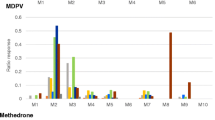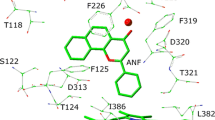Summary
Three groups of six 5-week-old Sprague Dawley female rats received i.p. injections of pregnandiol, 1.25, 2.50 or 5 mg/kg, respectively, in triolein daily for 7 days. Caffeine metabolism was studied in liver slices on day 8 by HPLC. Only primary metabolites were formed. N-1 demethylation was the most important pathway (theobromine represented 51% of total dimethylxanthines). Unlike in human in vitro or in vivo, 1,3,7-DAU (6-amino-5-(N-formylmethylamino)-1,3-dimethyluracil) was an important metabolite (9.7% of total caffeine metabolites). Pregnandiol inhibited N-1, N-3 and N-7 demethylation in vitro (−33%, −33% and −28%, respectively, at 5 mg/kg/day), but it had no effect on N-1 demethylation at 1.25 or 2.50 mg/kg/day. Pregnandiol at all doses had no effect on 1,3,7-trimethyluric acid and 1,3,7-DAU formation. These results are consistent with the hypothesis that C-8 hydroxylation and demethylation of caffeine are mediated by different isoenzymes. They indicate that pregnandiol is a potent inhibitor of microsomal drug metabolism, specifically of cytochrome P450 IA, which could explain the immaturity of some metabolic pathways of caffeine in neonates.
Similar content being viewed by others
References
Aranda J.V., Cook C.E., Gorman W., et al. (1979): Pharmacokinetic profile of caffeine in premature newborn infant with apnea. J. Pediatr., 94, 663–668.
Gorodischer, R., Karplus M. (1982): Pharmacokinetic aspects of caffeine in premature infants with apnea. Eur. J. Clin. Pharmacol., 22, 47–52.
Carrier O, Pons G., Rey E., et al. (1988): Maturation of caffeine metabolic pathways in infancy. Clin. Pharmacol. Ther., 44, 145–151.
Pons G., Carrier O., Richard M.O., et al. (1988): Developmental changes of caffeine elimination in infancy. Dev. Pharmacol. Ther., 11, 258–264.
Warazawaki D., Ben Zvi Z., Gorodischer R. (1981): Caffeine metabolism in liver alices during postnatal development in the rat. Biochem. Pharmacol., 30, 3145–3150.
Bonati M., Latini R., Marzi E., Cantoni R., Belvedere G. (1980): (2-14C)-caffeine metabolism in control and 3-methylcholanthrene induced rat liver microsomes by high pressure liquid chromatography. Toxicol. Lett., 7, 1–7.
Wietholtz H., Voegelin M., Arnaud M.J., Bircher J., Preisig R. (1981): Assessment of the cytochrome P-448 dependent liver enzyme system by a caffeine breath test. Eur. J. Clin. Pharmacol., 21, 53–59.
Nebert D.W., Adeanik M., Coon M.J., et al. (1987): The P-450 gene superfamily. Recommended nomenclature. DNA, 6, 1–11.
Kardish R., Feuer G. (1972): Relationship between maternal progesterones and the delayed drug metabolism in the neonate. Biol. Neonate, 20, 58–67.
Feuer G., Kardish R. (1975): Hormonal regulation of drug metabolism during pregnancy. Int. J. Clin. Pharmacol., 11, 366–374.
Soyka L.F., Long R.J. (1972): In vitro inhibition of drug metabolism by metabolites of progesterone. J. Pharmacol. Exp. Ther., 182, 320–327.
Tephly T.R., Mannering G.J. (1968): Inhibition of drug metabolism. V. Inhibition of drug metabolism by steroids. Mol. Pharmacol., 4, 10–14.
Juchau M.R., Fouts J.R. (1966): Effects of norethynodrel and progesterone on hepatic microsomal drug-metabolizing enzyme systems. Biochem. Pharmacol., 15, 891–898.
Berthou F., Ratanasavanh D., Riche C., Guillouzo A. (1988): Caffeine metabolism by human and rat hepatocytes in primary culture. In: Guillouzo A. (ed) Liver Cells and Drugs. London: Colloque INSERM/John Libbey Eurotext Ltd, pp. 287–292.
Arnaud M.J. (1985): Comparative metabolic disposition of (1-Me14C) caffeine in rats, mice and Chinese hamsters. Drug Metab. Dispos., 13, 471–478.
Kalow W., Campbell M. (1988): Biotransformation of caffeine by microsomes. ISI Atlas of Science, O809–9083, 381–386.
Berthou F., Ratanasavanh D., Riche C., Picart D., Voirin T., Guillouzo A. (1989): Comparison of caffeine metabolism by slices, microsomes and hepatocyte cultures from adult human liver. Xenobiotica, 19, 401–417.
Dean M.E., Stock B.H. (1975): Hepatic microsomal metabolism of drugs during pregnancy in the rat. Drug Metab. Dispos. 3, 325–331.
Grant D.M., Campbell M.E., Tang B.K., Kalow W. (1987): Biotransformation of caffeine by microsomes from human livers: kinetics and inhibition studies. Biochem. Pharmacol., 36, 1251–1260.
Sesardic D., Boobis A.R., Murray B.P., et al. (1990): Furafylline is a potent and selective inhibitor of cytochrome P450 IA2 in man: Br. J. Clin. Pharmacol, 29, 1251–1260.
Soyka L.F., Deckert F.W. (1974): Further studies on the inhibition of drug metabolism by pregnanolone and related steroids. Biochem. Pharmacol., 23, 1629–1639.
Author information
Authors and Affiliations
Rights and permissions
About this article
Cite this article
Bienvenu, T., Pons, G., Rey, E. et al. Effect of pregnandiol on caffeine metabolism in female rats. Eur. J. Drug Metab. Pharmacokinet. 18, 181–185 (1993). https://doi.org/10.1007/BF03188794
Received:
Issue Date:
DOI: https://doi.org/10.1007/BF03188794




